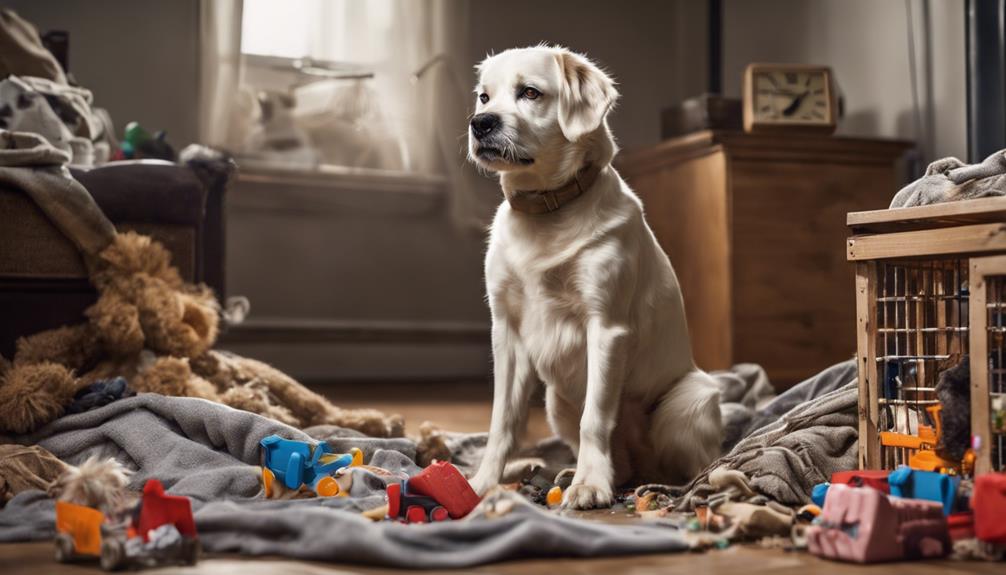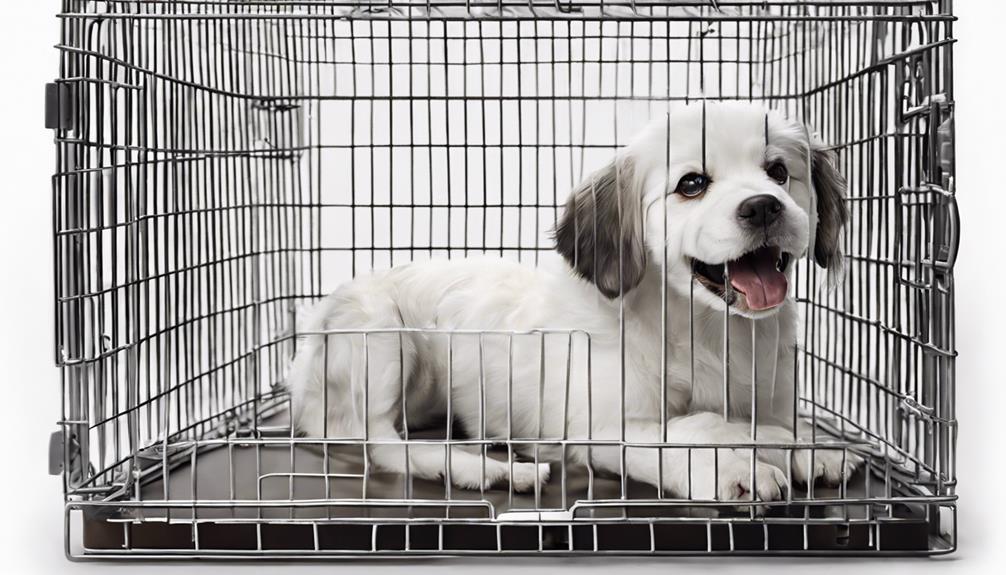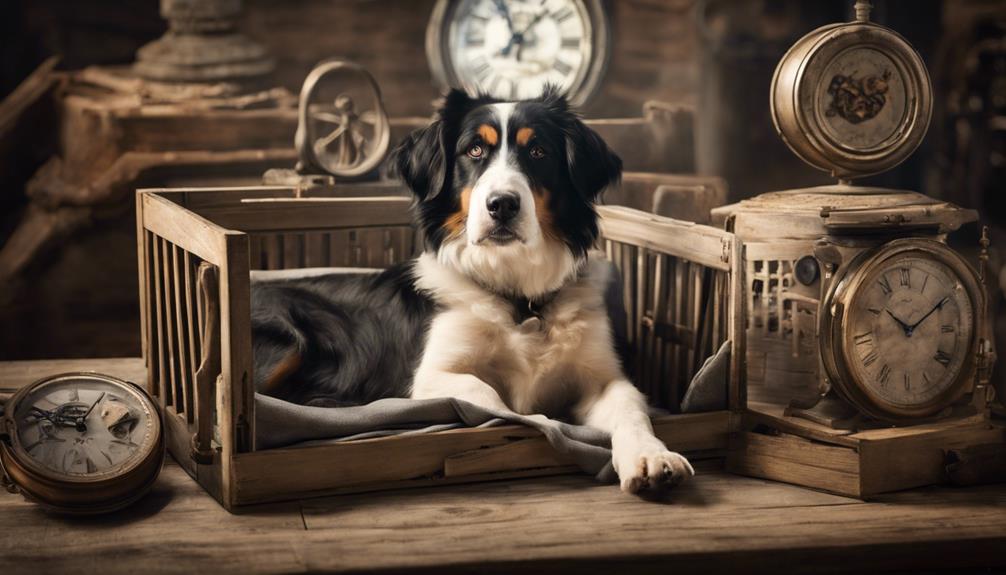Creating a schedule for crate potty training is essential to establish a routine for teaching your dog proper bathroom habits. This structured approach helps prevent accidents and sets a positive tone for overall behavior. Consistency around meal times, playtime, and rest ensures effective training and a happy, well-adjusted pet. Following a crate potty training schedule will set your furry friend up for success and strengthen your bond together.
Further insights await on optimizing your dog's training routine.
Key Takeaways
- Establish consistent feeding and watering times for routine.
- Gradually increase crate time to build bladder control.
- Incorporate playtime and short walks into the schedule.
- Monitor and respond to potty cues promptly.
- Maintain a structured daytime routine for successful training.
Benefits of Crate Training
Crate training plays a pivotal role in fostering a sense of security and discipline in puppies as they navigate the important stages of house training and behavioral development. It provides a structured schedule for potty training, teaching puppies to associate specific times with bathroom breaks. This consistency helps puppies understand when it's time to go potty, reducing accidents around the house. By introducing the crate as a safe space, puppies learn to view it as a positive association, aiding in managing separation anxiety and promoting a feeling of security.
Training a puppy to follow a schedule within the crate not only aids in potty training but also sets a routine for meal times, playtime, and rest. This structured approach helps in preventing bad behavior by giving the puppy a designated area for downtime and relaxation. Additionally, it creates a safe retreat for the puppy when feeling stressed or overwhelmed, promoting overall well-being and positive behavior. By utilizing the crate as a tool for training, puppies can learn to avoid accidents indoors and develop good habits from a young age.
Starting Crate Training Early

Starting crate training early sets the foundation for a positive and successful potty training schedule for puppies. When a puppy is around 8 weeks old, introducing crate training can be highly beneficial. Here are three key points to contemplate when commencing crate training early:
- Positive Association: Early introduction of the crate helps the puppy associate it with safety and comfort in their new environment. This positive connection can make the crate a secure space for the puppy to retreat to.
- Preventing Bad Behaviors: Starting crate training early can deter the development of undesirable behaviors. A well-structured crate training regimen can aid in house training and discourage destructive habits.
- Safe Retreat: The crate serves as a safe haven for the puppy, providing them with a secure space to relax and feel at ease. Making the crate inviting and cozy can help the puppy see it as their own special place.
Crate Training an Older Dog
Crate training an older dog can present unique challenges, such as breaking established habits and helping them adjust to a new routine.
We'll explore the difficulties that come with training senior dogs and offer effective solutions to make the process smoother.
Consistency and positive reinforcement will be our allies in guiding older dogs towards a positive association with their crate.
Senior Dog Crate Training
Exploring the process of initiating training for an older dog requires understanding their unique needs and behaviors to ensure a successful transition. When starting on senior dog crate training, it's crucial to keep in mind that older dogs may have established habits that take time to change. Here are key points to keep in mind:
- Patience and Consistency: Older dogs may require more time and patience to adapt to crate training due to their ingrained habits.
- Unlearning Old Habits: Focus on assisting your senior dog in letting go of old behaviors and establishing new ones through positive reinforcement.
- Creating Positive Associations: Make the crate a positive space by linking it with rewards and comfort to help in the adjustment process.
Challenges and Solutions
Understanding the challenges that come with crate training an older dog is essential for a successful shift to a new routine. Older dogs may have established habits that make the process more challenging. Patience and consistency are key in helping an older dog adapt to crate training.
Creating a positive association with the crate can aid in overcoming resistance. It's important to remember that training an older dog may require more time and effort due to their previous experiences. In emergency situations, illness, transportation, and stress relief, crate training can be beneficial for older dogs.
Developing a detailed training plan tailored to the individual needs of the older dog can help address specific challenges and ensure a smoother shift to using a crate.
Choosing the Right Crate Size

When it comes to selecting the appropriate crate size for your puppy, we must guarantee it allows for comfort and freedom of movement.
Choosing a crate that's too large might lead to unwanted accidents, while a crate that's too small can cause discomfort.
Taking into account your puppy's current size and potential adult size is crucial in finding the perfect fit for successful potty training.
Size for Comfort
Selecting the right crate size for your puppy is crucial to ensure they've enough space to move comfortably. When choosing a crate size for your puppy, keep the following in mind:
- Comfortable Crate Size: Make sure the crate allows your puppy to stand up, turn around, and lie down without restrictions.
- Accommodate Growth: Choose a crate that will grow with your puppy to provide long-term comfort.
- Adult Size Consideration: Take into account the eventual size of your puppy's breed to select an appropriate crate size.
Properly sizing your puppy's crate will prevent feelings of confinement and discomfort, ultimately leading to a happier and more relaxed potty training experience for both you and your furry friend.
Fit for Training
To ensure your puppy's comfort and success in crate training, it's important to carefully consider the appropriate crate size that allows for proper movement and growth. Choosing the right crate size is essential in the Ultimate Puppy Crate Training Schedule. Your puppy should have enough space to stand up, turn around, and lie down comfortably.
It's essential to select a crate that will accommodate your puppy's adult size to prevent the need for frequent replacements. Using a crate with dividers can be helpful, as it adjusts to your puppy's growth, providing a snug space without excess room. The correct crate size not only contributes to successful crate training but also helps establish a positive routine for your puppy, ensuring they've a comfortable time in their crate during potty breaks and while sleeping.
Daytime Crate Training Routine

Let's establish a daytime crate training routine that includes scheduled potty breaks every 2-3 hours to help your puppy develop good habits. Here's how to structure your puppy's daytime schedule effectively:
- Consistent Feeding and Watering Times: Set regular feeding times to create a predictable bathroom schedule. Limit water intake before bedtime to reduce nighttime accidents.
- Incorporate Playtime and Short Walks: Engage your puppy in playtime and short walks to prevent boredom and encourage potty opportunities. Monitor their behavior for cues that they need to relieve themselves.
- Gradual Crate Time Increase: Slowly extend the time your puppy spends in the crate during the day to improve bladder control. Use positive reinforcement and rewards for successful potty breaks outside the crate.
Nighttime Crate Training Tips

As we shift our focus to Nighttime Crate Training Tips, ensuring a peaceful bedtime routine plays a vital role in setting your puppy up for success in overnight potty training. Engaging in physical activities before bedtime can help tire out your puppy, making it more likely for them to have a restful night.
Establish a calming bedtime routine with consistent elements like a soothing bedtime story or gentle petting to signal that it's time for sleep. Consider using a toy with a heartbeat sound to comfort your puppy during the night, providing a sense of security.
During nighttime potty breaks, maintain a calm atmosphere by avoiding playful interactions that could disrupt the sleepy mood. Positive reinforcement is essential – praise your puppy for successful bathroom breaks outside to reinforce good behavior.
Common Crate Training Issues

Crate training commonly presents challenges such as whining, barking, and resistance from dogs when entering the crate. Addressing these common issues is vital for successful potty training a puppy or crate training an older dog. Here are some insights into common crate training problems:
- Whining and Barking: Dogs may vocalize their anxiety, fear, or frustration through whining and barking when placed in a crate. Understanding the root cause of this behavior is important to address it effectively.
- Resistance to Entering the Crate: Some dogs exhibit resistance when it comes to entering the crate, which can stem from negative associations, anxiety, or fear. Patience and positive reinforcement are key in overcoming this hurdle.
- Confusion and Setbacks: Inconsistent crate training schedules or lack of clear guidance can lead to confusion and setbacks in the training process. Establishing a routine and providing consistent cues can help mitigate these challenges.
Crate Training Do's and Don'ts

To foster a positive and effective crate training experience for your puppy, it is essential to understand and follow key do's and don'ts. Gradually increasing the time your puppy spends in the crate can prevent anxiety or distress. It's vital to use the crate as a safe place, not as a form of punishment. Making sure the crate is appropriately sized for your puppy's comfort and growth is a necessity, while also avoiding leaving your puppy in the crate for extended periods without breaks for potty and playtime. Positive reinforcement and rewards when your puppy willingly enters the crate can help create a positive association with it.
| Do's | Don'ts |
|---|---|
| Gradually increase crate time | Use crate as punishment |
| Make sure crate is appropriately sized | Leave puppy in crate for extended periods without breaks |
| Use positive reinforcement and rewards |
Frequently Asked Questions
How Long Do You Leave a Dog in a Crate for Potty Training?
We leave our dog in the crate for potty training based on their age and bladder control. Balancing crate time with regular potty breaks and playtime outside is key. Monitoring behavior helps adjust crate duration for successful training.
Does Crate Training Work for Potty Training?
Yes, crate training works for potty training. Dogs learn to control their bladder and wait to eliminate outside. Crates establish a routine for potty breaks, reducing accidents. Consistent crate use accelerates housebreaking and reinforces good habits.
What Is a Good Crate Training Schedule?
A good crate training schedule involves consistent feeding times to regulate bathroom breaks. Scheduled potty breaks help establish a routine and bladder control. Gradually increasing crate time helps adjust to spending time in it. Positive reinforcement maintains positive associations with training.
How Do You Crate Train and Potty Train at the Same Time?
We coordinate crate training and potty training by establishing a routine. We integrate potty breaks into the schedule, reward success, and supervise closely to prevent accidents. Consistent timing and positive reinforcement help reinforce good potty habits during this training journey.
What is the Best Crate Training Schedule for Potty Training a Dog?
When creating a crate training potty schedule for your dog, it’s important to start with frequent potty breaks, such as every 2-3 hours. Over time, you can gradually increase the time between breaks as your dog becomes more reliable. Consistency and positive reinforcement are key to successful crate training.
Conclusion
To sum up, crate training can provide numerous benefits for both you and your furry friend.
Did you know that 80% of dogs adopted from shelters exhibit fewer behavioral problems when crate trained?
By starting early, choosing the right size crate, and following a consistent routine, you can help your dog feel safe and secure while also promoting good behavior.
Remember, patience and positive reinforcement are key to successful crate training!









